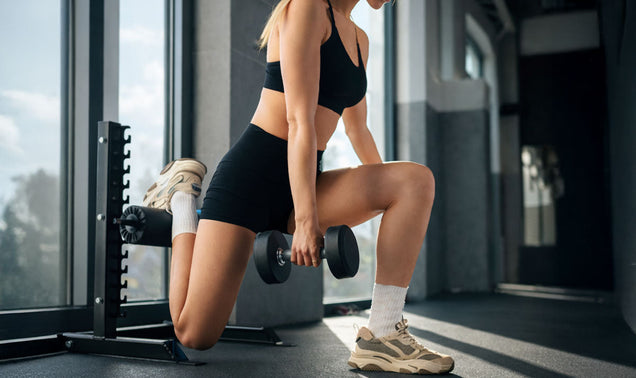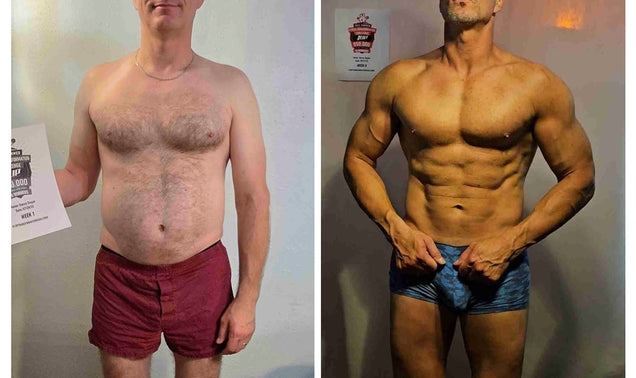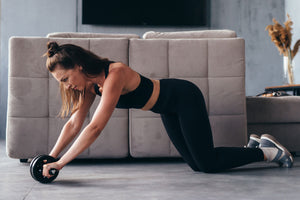Vo2 max is a measure of the maximum amount of oxygen your body can use during exercise. It is used as an indicator of cardiorespiratory fitness as well as a marker for overall health and longevity.
For example, higher levels of cardiorespiratory fitness (VO2max) have been found to support cardiovascular health, increased lifespan, better sleep, and greater mood.[1,2,3] On the flip side, lower levels of cardiovascular fitness are associated with increased risk of lifestyle-induced disorders, worse sleep, poorer mood, and shorter lifespan.[3,4,5]
What this means is that, even if you’re not a competitive athlete, improving your Vo2 max is important, not only for your performance and physique but your overall health and longevity as well.
Let’s now discuss 6 ways to improve Vo2 max.
Ways to Improve Vo2 Max
High-Intensity Interval Training (HIIT)
The best way to increase your Vo2 max is to exercise near your maximum heart rate. In fact, research demonstrates that training between 80–92.5% VO2max leads to improvements.[6]
As you might have guessed, training at that high of an intensity is quite demanding. To correctly perform high-intensity interval training, you have to go all out. That means during your work intervals you’re giving it everything you have (while still maintaining proper form), and during your rest/active recovery periods, you rest. But, the second the next work interval starts you GO!
When programming HIIT workouts, remember to keep the proper work to rest ratios. Far too many workouts that claim to be “HIIT” workouts fall into the category of moderate-intensity (which we’ll discuss next).
HIIT protocols usually involve a 1:1 or 1:2 work to rest ratio where you rest an equivalent or longer amount of time than you are exercising “all out.” The reason for this is that you can train two ways -- long or hard. You can’t really do both.
The body has a finite capacity to go all-out, and when it can’t train at the upper threshold anymore, training intensity is reduced for the same duration. That’s why with HIIT, typical workouts are 15-20 minutes max. This also means that those “60 minute HIIT workouts” you see on YouTube are more inline with our next way to improve Vo2 max.
Lower-Intensity Training (LIT)
Lower-intensity training, more commonly referred to as moderate-intensity continuous training (MICT), can also be effective for increasing your Vo2 max. LIT/MICT is usually defined as 30–60 minutes of moderate-intensity exercise at 40% to <60% of oxygen consumption reserve.[6]
It may not be as sexy or exciting as HIIT, but there’s a reason why top-tier coaches have their elite athletes spend a lot of “training low.” Training at lower intensities helps to strengthen your heart muscle, improve VO2 max, and increase your “staying” power.
Mix HIIT and MICT
By mixing things up in your training and incorporating both continuous training and interval training in your workout program has been shown to be effective for improving Vo2 max. In fact, research demonstrates that using a variety of training approaches (also known as concurrent training) may be more effective than only performing one style of training.[7]
Utilizing both types of cardio training into your weekly workout program can help to manage recovery and avoid overuse injuries. So, if you have three cardio sessions planned per week, dedicate one of them to HIIT and two of them to LIT/MICT or vice versa.
This also helps to keep things fresh and interesting with your workouts so that you can continue to show up consistently and get better results faster!
Circuit Training
Cardio isn’t the only way to increase your vo2 max, resistance training can as well. Specifically, circuit training with resistance-based exercises (bench press, push ups, squats, rows, etc.) has been shown to be effective at improving Vo2 Max (as well as muscle strength).[8]
As with HIIT, you have to be training at a certain intensity while being mindful of your rest intervals. In addition to building muscle and boosting cardiovascular fitness, circuit training is a great way to train efficiently, burn calories, boost metabolism, and support weight loss!
Play Recreational Sports
Translating those muscle and strength gains you’ve made in the gym onto the field of competition is yet another way to improve Vo2 max. Research shows that participating in recreational sports that involve periods of intense effort, such as soccer or basketball, can improve Vo2 max.[9] Heck, you may even be able to increase your vo2 max playing pickleball (one of America’s latest crazes), if you get after it hard enough!
Supplements
Last, but not least, supplements may also help to improve your vo2 max. Keep in mind that just taking the supplements by themselves won’t lead to a better vo2 max, but if you’re training consistently with a high level of effort, certain supplements can help you to further increase your vo2 max than you would without using them.
Among the supplements found by researchers to help athletes improve vo2 max (as well as time-to-exhaustion, strength, and a whole host of other markers), are beta alanine, caffeine, and citrulline. These three powerful ergogenic are included in every serving of 1UP Pre Men and 1UP Pre Women at their research-backed dosages.
Takeaway
VO₂ max is an important benchmark for measuring your cardiorespiratory (aerobic) fitness level since it tells you how efficiently your body is using oxygen. It’s also a valuable predictor of overall health, fitness, and longevity.
You can increase your Vo2 max through interval training, moderate intensity cardio, circuit training, rec sports, or a combination of two or more of them. Supplements can also help to improve your VO₂ max, but only if you’re training hard consistently.
For help figuring out what workouts help improve vo2 max, download the 1UP Fitness App where we offer customized training and nutrition recommendations to help you meet your fitness and physique goals!
References
- Kandola A, Ashdown-Franks G, Stubbs B, Osborn DPJ, Hayes JF. The association between cardiorespiratory fitness and the incidence of common mental health disorders: A systematic review and meta-analysis. J Affect Disord. 2019 Oct 1;257:748-757. doi: 10.1016/j.jad.2019.07.088. Epub 2019 Jul 30. PMID: 31398589; PMCID: PMC6997883.
- Burtscher J, Ruedl G, Posch M, Greier K, Burtscher M. The upper limit of cardiorespiratory fitness associated with longevity: an update. AIMS Public Health. 2019 Jul 4;6(3):225-228. doi: 10.3934/publichealth.2019.3.225. PMID: 31637272; PMCID: PMC6779597.
- D.-c. Lee, X. Sui, E. G. Artero et al., “Long-term effects of changes in cardiorespiratory fitness and body mass index on all-cause and cardiovascular disease mortality in men,” Circulation, vol. 124, no. 23, pp. 2483–2490, 2011.
- Bye A, Røsjø H, Aspenes ST, Condorelli G, Omland T, Wisløff U. Circulating microRNAs and aerobic fitness--the HUNT-Study. PLoS One. 2013;8(2):e57496. doi: 10.1371/journal.pone.0057496. Epub 2013 Feb 28. PMID: 23469005; PMCID: PMC3585333.
- Tolmunen, T., et al. “Low Maximal Oxygen Uptake Is Associated with Elevated Depressive Symptoms in Middle-Aged Men.” European Journal of Epidemiology, vol. 21, no. 9, 2006, pp. 701–06. JSTOR, http://www.jstor.org/stable/20445746. Accessed 20 Jan. 2024.
- T. D. Scribbans, S. Vecsey, and P. B. Hankinson, “The effect of training intensity on VO2max in young healthy adults: a meta-regression and meta-analysis,” International Journal of Exercise Science, vol. 9, no. 2, pp. 230–247, 2016.
- Bacon, A. P., Carter, R. E., Ogle, E. A., & Joyner, M. J. (2013). VO2max Trainability and High Intensity Interval Training in Humans: A Meta-Analysis. PLOS ONE, 8(9), e73182. https://doi.org/10.1371/journal.pone.0073182
- Muñoz-Martínez FA, Rubio-Arias JÁ, Ramos-Campo DJ, Alcaraz PE. Effectiveness of Resistance Circuit-Based Training for Maximum Oxygen Uptake and Upper-Body One-Repetition Maximum Improvements: A Systematic Review and Meta-Analysis. Sports Med. 2017 Dec;47(12):2553-2568. doi: 10.1007/s40279-017-0773-4. PMID: 28822112.
- Milanović Z, Pantelić S, Čović N, Sporiš G, Krustrup P. Is Recreational Soccer Effective for Improving VO2max A Systematic Review and Meta-Analysis. Sports Med. 2015 Sep;45(9):1339-1353. doi: 10.1007/s40279-015-0361-4. PMID: 26210229; PMCID: PMC4536283.
- Ghiasvand R, Askari G, Malekzadeh J, Hajishafiee M, Daneshvar P, Akbari F, Bahreynian M. Effects of Six Weeks of β-alanine Administration on VO(2) max, Time to Exhaustion and Lactate Concentrations in Physical Education Students. Int J Prev Med. 2012 Aug;3(8):559-63. PMID: 22973486; PMCID: PMC3429803.
- Stadheim, H. K., Stensrud, T., Brage, S., & Jensen, J. (2021). Caffeine Increases Exercise Performance, Maximal Oxygen Uptake, and Oxygen Deficit in Elite Male Endurance Athletes. Medicine and Science in Sports and Exercise, 53(11), 2264–2273. https://doi.org/10.1249/MSS.0000000000002704
- Bailey SJ, Blackwell JR, Lord T, Vanhatalo A, Winyard PG, Jones AM. l-Citrulline supplementation improves O2 uptake kinetics and high-intensity exercise performance in humans. J Appl Physiol (1985). 2015 Aug 15;119(4):385-95. doi: 10.1152/japplphysiol.00192.2014. Epub 2015 May 28. PMID: 26023227.






